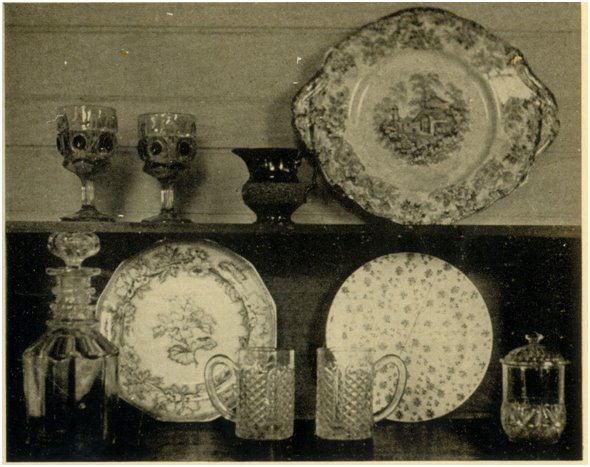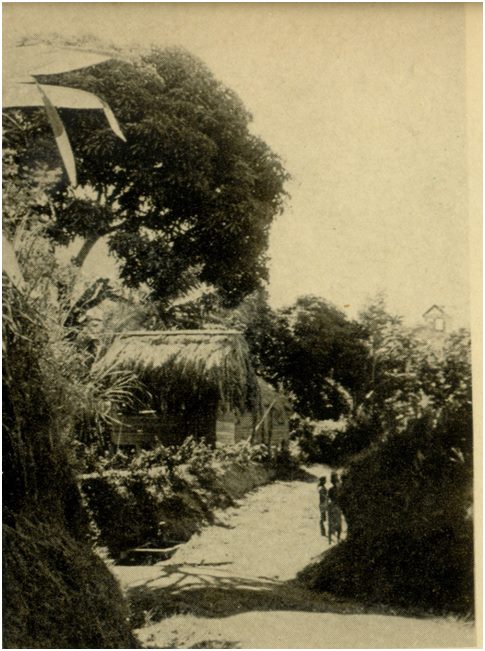|
Some of the centuries-old china and glassware found in 1939 in a hut at Studley Park In the 18th century, the quip ‘AS RICH AS A TOBAGO PLANTER’ was bandied about in England to describe someone of great wealth. This was no idle comparison either, since the island was one of the most coveted in the West Indies, constantly being fought over by the English , Dutch and French, and covered in plantations which produced over two million hogsheads of sugar annually. Before Emancipation in 1834, the Tobago planters resided in magnificent houses perched atop breezy hills overlooking waving canefields, their every physical need seen to by an army of slaves. The furnishings of the houses were of the best, porcelain from China, Dresden , crystal from Venice and the like. After apprenticeship ended in 1838, things changed only marginally since Tobago (unlike Trinidad) had no arable crown lands for ex slaves to squat upon, so unless they emigrated, the emancipated Tobagonians had no recourse but to return to the estates to work for wages. The system of sharecropping or metayage was introduced to keep the sugar estates in business and this lasted until the last shreds of Tobago agriculture were destroyed by Hurricane Flora in 1963. The turning point in the fortunes of Tobago planters occurred in 1847 following a severe hurricane which caused extensive ruin. A few months later, the West India Bank in the UK collapsed. This was almost the sole source of financing for all the estates in Tobago. Estate owners were left without the means of paying for goods and services since many, despite their extravagant lifestyles, existed on credit. A few old families like the Croooks, Hamiltons and Youngs bit in and struggled with their dilemma. The rest simply abandoned their holdings lock stock and barrel and the once palatial great-houses were plundered by the metayers and other common folks for their contents which is where the story becomes interesting. Fast forward to 1939 when two Americans, Heath and Jefferson Bowman are on a long vacation in the great-house of Terry Hill Estate. A detailed story of their stay exists which shows in clear evidence that Tobago society and its stratifications had evolved very little since Emancipation over a century earlier. Their friend, Debbie Currier informed them of a treasury of 18th century porcelain, pewter, silverware and crystal which could be found carefully preserved in some of the poorest homes in Tobago, those of the descendants of the metayers. The systematic dismantling of the abandoned estate housing following the crisis of 1847 had yielded for the simple, gentle and rootsy Tobagonians a booty of crockery and napery fit for nobility. Some of it had been bought up by Mrs. Hamilton (of one of the old clans who survived the 1847 crisis) who lived at Greenhill. The collection included the finest Bohemian, hurricane lamps with delicate glass shades three feet tall and shilling-mugs all of 18th century vintage. Inspired, the Bowmans tackled some of the older families in and around Studley Park estate where many were able to trace their roots back to slavery. In one house, they were able to acquire two plates of T.Godwin Burnselm Stone China which came from one of the best manufactures of the period as well as a large willow china serving dish, all in mint condition. The lot cost them two dollars which would be about a couple hundred dollars or so in present value. In a shack near Studley Park occupied by a stately old woman and her grandchildren was a rough board shelf breaking with treasures. Not only were there the famous shilling mugs but also a china trinket box, willow porcelain plates and best of all, a delicate china figurine of 17th century origin depicting Rosalind, a Shakespearean character. The whole lot was acquired for a dollar and some change which was one of the ironies of the whole set of crockery discoveries ….the Tobagonians had preserved these rare and delicate items in mint condition for near upon a century though completely oblivious and unaware of their true value, yet they were willing to part with them for peanuts. In this way, most of the heirlooms of Tobago were lost. Some bits and pieces still exist in private homes as I have seen for myself, but the bulk was sold and left the island. The Bowmans acquired a few other pieces and left the island. A small and poor sample of the treasures which may have been can be seen today in the Tobago museum at Fort King George, the fine china reminiscent of an era long gone. Author : Historian Angelo Bissessarsingh. The hut at Studley Park in 1939 which concealed a treasury of antiques
0 Comments
Leave a Reply. |
T&T news blogThe intent of this blog is to bring some news from home and other fun items. If you enjoy what you read, please leave us a comment.. Archives
June 2025
Categories
All
|



 RSS Feed
RSS Feed